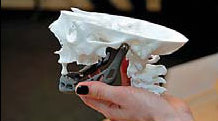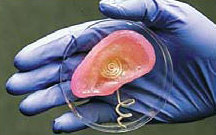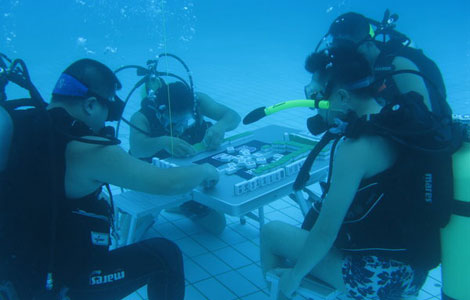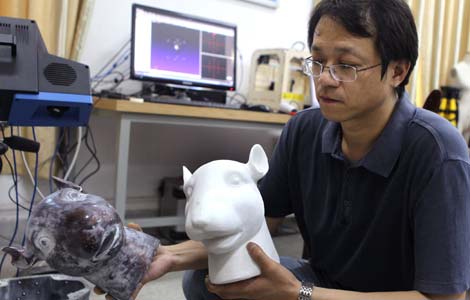At a glance
Updated: 2013-08-14 07:40
(China Daily)
|
||||||||

In 2002 CT and MRI data was used to 3-D print anatomical models of conjoined twins from Egypt in the United States, to plan for the separation surgery. The surgery succeeded in 2003, and the twins lived six years.
In 2011, researchers in Belgium and the Netherlands created and implanted an entire 3-D printed lower jaw (pictured above) for an 83-year-old woman. It was the world's first complete 3-D printed implant.
In 2012, specialists in the US created an airway device with a 3-D laser printer with approval from the US Food and Drug Administration, and saved a baby boy, whose birth defect had caused his throat's airway to collapse frequently.
In February 2013, scientists at Cornell University announced it had used 3-D printing to create an artificial ear for treating ear deformity.
In March, US doctors used 3-D printed artificial skull bones, and replaced 75 percent of a patients' skullcap that had been severely damaged, with approval from the FDA.
In April, scientists in the US managed to create mini versions of liver using a 3-D printer. They built up layers of liver cells, including cells from the lining of blood vessels to nourish the liver cells with nutrients and oxygen.

In May, scientists at Princeton University announced they had printed a working human ear (pictured) with electric and organic materials, including cow cells. The replica ear can hear beyond human ability.
China Daily
(China Daily USA 08/14/2013 page9)

 Huawei unveil Ascend P6 smartphone in Vienna
Huawei unveil Ascend P6 smartphone in Vienna
 That's one cool game of mahjong
That's one cool game of mahjong
 Isinbaeva leads harvest day for host Russia
Isinbaeva leads harvest day for host Russia
 Perseid meteor shower puts on show in night sky
Perseid meteor shower puts on show in night sky
 Bird flu, slowdown hit sales at fast-food chains
Bird flu, slowdown hit sales at fast-food chains
 PetroChina poised to dominate Iraqi oil
PetroChina poised to dominate Iraqi oil
 Marriage attitudes slowly change
Marriage attitudes slowly change
 On frontline of fight against crime
On frontline of fight against crime
Most Viewed
Editor's Picks

|

|

|

|

|

|
Today's Top News
Brazil demands clarifications on NSA surveillance
2nd-generation ID cards to include fingerprints
Chinese students boost boarding business in US
TCM chain probed after illegal house exposed
Friends of accused Boston bomber due in court
Economic hub on Bohai Bay
PM to visit China for milk scare
Donors of organs easing transplant shortages
US Weekly

|

|




